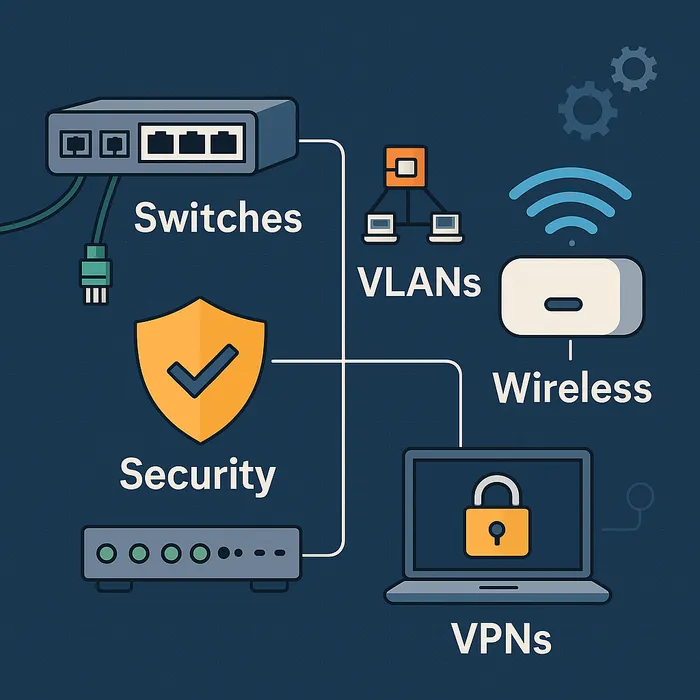Do You Know Your Network? Part 3: Switches, VLANs, Wireless, and the Art of Structured Connectivity

The router may be the gatekeeper, but it’s the switches, VLANs, Wi-Fi access points, and security architecture that truly determine the strength and scalability of your network.
Image: Supplied / Kathea
By Benjamin Liebenberg
Walk into any server room or network cabinet, and you’ll often know exactly how that business runs.If the cabling looks like spaghetti and unmanaged switches hang like ornaments, chances are good that the network — and perhaps the company — is reacting, not planning.
The router may be the gatekeeper, but it’s the switches, VLANs, Wi-Fi access points, and security architecture that truly determine the strength and scalability of your network.
This is where control happens. Where segmentation lives. Where performance is won or lost.
Switches: More Than Ports and Blinking Lights
The humble network switch doesn’t get nearly the recognition it deserves.In a modern business network, switches are the invisible hands directing internal traffic with precision. Every file shared, every print job sent, every VoIP call made inside your building likely travels through one.
But not all switches are created equal.
Many smaller offices still rely on unmanaged switches — basic, inexpensive boxes with no oversight. They're fine for simple tasks, but in today’s security-focused, multi-tenant environments, they pose risks.
Managed switches, on the other hand, provide control:
- Assign VLANs per port.
- Monitor bandwidth and spot anomalies.
- Prioritize traffic using QoS.
- Harden access through port security.
Popular Enterprise Switch Brands:
- Cisco Catalyst Series – the gold standard for managed, scalable enterprise switching.
- Aruba (HPE) – smart switching with deep integration into wireless infrastructure.
- Ubiquiti UniFi – ideal for small/medium businesses that need visibility without the complexity.
- Netgear ProSAFE – affordable, managed solutions for growing networks.
- Juniper EX Series – high-performance data center switches with robust automation.
Smart switches don’t just connect — they govern.
VLANs: Drawing Invisible Walls
A VLAN (Virtual Local Area Network) lets you segment your internal network — not by cables, but by logic. Imagine creating invisible, policy-driven boundaries around departments, device types, or access levels.
Need to isolate guest users? Create a VLAN.Want a dedicated channel for IP phones or surveillance cameras? VLAN.Finance shouldn’t live on the same network as public displays or R&D — and they don’t have to.
The best part? You can do this all from your switch interface or central network controller.
Wi-Fi: Convenience With a Catch
Wireless access is a lifeline — but also a vulnerability.
A solid wireless strategy blends coverage, control, and compliance:
- Use multiple SSIDs linked to VLANs to separate traffic.
- Centralize authentication through RADIUS and 802.1X.
- Apply band steering, AP isolation, and load balancing for performance and safety.
Top Enterprise Wi-Fi Solutions:
- Aruba Networks (HPE) – intelligent, cloud-managed Wi-Fi with AI-powered optimization.
- Cisco Meraki – plug-and-play enterprise Wi-Fi with deep analytics and remote management.
- Ubiquiti UniFi APs – cost-effective, scalable Wi-Fi with visual dashboards.
- Ruckus Wireless (CommScope) – high-density wireless with smart antenna tech.
- Fortinet FortiAPs – secure Wi-Fi integrated into broader firewall and threat management.
Bonus: Always start with a Wi-Fi site survey using tools like Ekahau, NetSpot, or Acrylic Wi-Fi Heatmaps to plan placement, eliminate dead zones, and optimize coverage.
Security: Hardening the Interior
Threats don’t always knock at the front door. Many sneak in through poorly segmented networks, rogue access points, or forgotten open ports.
Modern switches and wireless systems must support:
- 802.1X for endpoint authentication.
- Network Access Control (NAC) to ensure device compliance.
- Port isolation, MAC filtering, and guest access control.
This internal hardening is no longer optional — it’s foundational.
VPNs: Extend the Network, Not the Risk
VPNs are essential — but they must be implemented securely.
Whether you're bridging offices or empowering remote workers, consider:
- IPSec for full tunnel encryption.
- SSL VPNs for browser-based app access.
- MFA (multi-factor authentication) and device compliance checks before granting access.
Ensure your VPN infrastructure supports role-based access and logs every session. Integrations with Fortinet, Cisco AnyConnect, OpenVPN, or Cloudflare Tunnel can all offer enterprise-grade access.
The Often-Neglected Layer: Cabling and Planning
Your network is only as good as its physical foundation.
A poorly managed cabling setup leads to:
- Longer downtimes during troubleshooting.
- Accidental disconnects.
- Fire risks and signal interference.
Network Cabling Best Practices:
- Use labeled patch panels and color-coded cables by purpose (e.g., VLANs, uplinks, PoE).
- Maintain tight, vertical cable runs using Velcro (not zip ties).
- Follow TIA/EIA standards for horizontal and backbone cabling.
- Document every port, MAC address, VLAN, and purpose — preferably inside a network planning tool.
Recommended Planning & Mapping Tools:
- NetBox – open-source IP address and device inventory management.
- Lucidchart / Draw.io – simple visual topology mapping.
- SolarWinds Network Topology Mapper – automated scanning and map generation.
- Microsoft Visio – classic enterprise-standard for physical and logical network layouts.
Final Thought: Order, Not Chaos
The best networks are quiet, invisible — and intentional.A strong core of managed switches, segmented VLANs, properly secured wireless, and logical remote access makes the difference between constant firefighting and effortless scalability.
When your team grows, a new building opens, or a new vulnerability emerges — will your network respond with clarity or confusion?
Get to know your network. Really know it. Because performance, security, and future readiness all start here.
* Benjamin Liebenberg is CTO at Kathea Communication.
** The views expressed do not necessarily reflect the views of IOL or Independent Media.
Related Topics:
